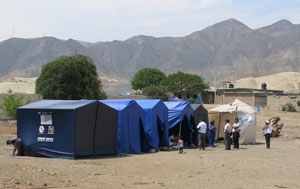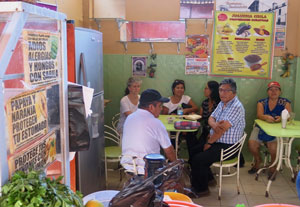A letter from Sara Armstrong and Rusty Edmondson, serving in Peru
March 2017
Write to Sara Armstrong
Write to Rusty Edmondson
Individuals: Give online to E200530 for Sara Armstrong and Rusty Edmondson’s sending and support
Congregations: Give to D507510 for Sara Armstrong and Rusty Edmondson’s sending and support
Churches are asked to send donations through your congregation’s normal receiving site (this is usually your presbytery).
The alarm clock rang at 4:30 am; the coffee maker began producing a pot of needed java. Jenni the dog opened one eye to ensure this wasn’t a dream, then went back to sleep. Smart dog!
We made it out the door at 5:00, crossed Lima, and met our three colleagues from the Peruvian Evangelical Church—the Iglesia Evangélica Peruana (IEP). We boarded a bus and traveled from Lima five hours north to the town of Paramongo. Our purpose was to visit communities that were severely damaged by recent flooding in Peru but had not received much relief assistance. (As in all disasters, some communities are inundated with help while many others don’t receive immediate aid.)
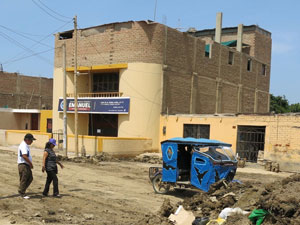 We arrived in Paramongo and were met by an elder of the local IEP. She gave us a quick tour of the church and the damaged areas in town. (See the photo of the church that is closed this week as everyone cleans up.) We were amazed at the community’s quick cleanup response. We expected to find the rotten smell of flood mud, but instead the cleanup efforts and the heat of the day were producing clouds of fine brown dust. Many people were wearing masks, and we wished we had brought some too.
We arrived in Paramongo and were met by an elder of the local IEP. She gave us a quick tour of the church and the damaged areas in town. (See the photo of the church that is closed this week as everyone cleans up.) We were amazed at the community’s quick cleanup response. We expected to find the rotten smell of flood mud, but instead the cleanup efforts and the heat of the day were producing clouds of fine brown dust. Many people were wearing masks, and we wished we had brought some too.
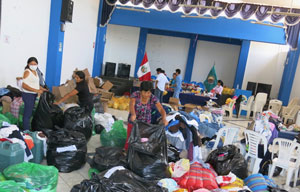 Next we met with the local Disaster Management Director at the Paramongo Municipal Building, who had been working day and night for over a week and was doing a good job of coordinating disaster relief. (See photo of the donations being sorted by volunteers for distribution in the Paramongo area.) She confirmed that the two small local communities of Sigual and Empedrada, home to people who work in the extensive sugarcane fields in the region, had suffered from the flooding and had received only a very basic response.
Next we met with the local Disaster Management Director at the Paramongo Municipal Building, who had been working day and night for over a week and was doing a good job of coordinating disaster relief. (See photo of the donations being sorted by volunteers for distribution in the Paramongo area.) She confirmed that the two small local communities of Sigual and Empedrada, home to people who work in the extensive sugarcane fields in the region, had suffered from the flooding and had received only a very basic response.
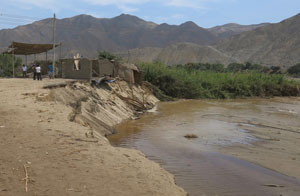 Along with five pastors and lay people from the IEP, we squeezed into a taxi and drove half an hour east of Paramongo, seeing signs of flood damage along the way. We turned off on a muddy road through the sugarcane fields into Empedrada, a small village on a hill between extensive sugarcane fields and the Fortaleza River, formerly home to 28 families. There we noticed something very unusual. A few weeks ago, there were community orchards of mangos, passion fruit, bananas and avocados between the village and the river. The force of the floodwaters had changed the course of the river, directing it toward Empedrada and Sigual. Raging waters eroded the sandy foundations on that hill and eventually washed away 11 homes and all of the fruit trees. They also damaged the community well and much of the water and wastewater infrastructure. (See the photo of the new sand bluff where houses once stood.)
Along with five pastors and lay people from the IEP, we squeezed into a taxi and drove half an hour east of Paramongo, seeing signs of flood damage along the way. We turned off on a muddy road through the sugarcane fields into Empedrada, a small village on a hill between extensive sugarcane fields and the Fortaleza River, formerly home to 28 families. There we noticed something very unusual. A few weeks ago, there were community orchards of mangos, passion fruit, bananas and avocados between the village and the river. The force of the floodwaters had changed the course of the river, directing it toward Empedrada and Sigual. Raging waters eroded the sandy foundations on that hill and eventually washed away 11 homes and all of the fruit trees. They also damaged the community well and much of the water and wastewater infrastructure. (See the photo of the new sand bluff where houses once stood.)
Visiting with the community leader, we learned that the families whose homes were destroyed had been moved to tent shelters 10 minutes away in the community of Cerro Blanco. We drove to the small town of Cerro Blanco to find the tent camp for refugees from the communities of Sigual and Empedrada. These people were coping with their situation in hot tents. They conversed with the IEP leaders not only about their destroyed homes, but also about when and where they could rebuild since their land was also washed away. But the immediate concern was with basic necessities to get them through the next few weeks. (See photos of the government blue tents and communal kitchen.)
Conversations determined the essential needs for these displaced families and a plan was agreed upon. After receiving permission to proceed with this response plan from the Paramongo Disaster Management Director, our group returned that night to Lima. Two days later, our IEP partners drove large trucks loaded with tons of essential supplies (donated potatoes, containers of purified water, children’s clothes, cooking utensils, beds, bedding, personal hygiene supplies, medical supplies, and prepared food items) for distribution to suffering families in Sigual, Empedrada and Paramongo.
Disaster Relief was not how we planned to begin our new partnership with Red Uniedo Manos-Peru (RED)! This Peruvian not-for-profit networks with other NGOs that focus on justice and hunger issues in Peru. RED also partners with the PC(U.S.A.) Joining Hands Against Hunger program and the Young Adults Volunteer program. We had other plans, but Peru’s disastrous flooding has changed the course of our work in much the same way that the Rio Fortaleza changed course near Sigual. With RED and IEP guidance, we have begun collaborating on relief efforts, involving the PC(U.S.A.) partners in short- and long-term disaster response.
The Peruvian police and military have performed amazing well with heroic rescues and herculean efforts. The Peruvian people are showing up in astonishing numbers to volunteer and provide aid.
If you want to be amazed and awed at the power of nature, search the internet for “Peru Floods 2017.” Below is a link to an article that details and provides moving photos of the flood’s devastation and a link to a video that vividly demonstrates nature’s power to wreak havoc:
http://climatestate.com/2017/03/19/peru-flooding-disaster-footage-compilation-march-2017/
This disaster is not over. People on the coast are very aware as they clean up and restock that more flooding could come. Several rivers within the Amazon basin are approaching flood stage, with more rain in the forecast for April and May.
The PC(U.S.A.), RED and the IEP will continue supporting the immediate response efforts. Then, in solidarity we will begin the long-term effort of rebuilding homes and disrupted lives. This long-term effort will include community training on disaster prevention.
Many of you have asked how you can help. Presbyterian Disaster Assistance (PDA) has sent funds to RED for immediate assistance in Peru. They also established a special account so that Presbyterians can give to disaster relief. If you wish to contribute funds to relief and reconstruction efforts, here is the link to the PDA Peru fund:
https://pma.pcusa.org/donate/make-a-gift/gift-info/DR000179/
As the waters recede, our partners in RED and the IEP will define work projects and request mission teams to support the reconstruction efforts. We will keep you updated as the recovery unfolds. Thank you for your prayers and faithful support for those with whom we serve “aquí en Perú.”
Saludos de Rusty y Sara
UPDATED DATA ON THE IMPACT:
Below are estimates of the damages that have been released by the National Center for Emergency Operations (COEN) as of April 1, 2017. However, numerous small, rural communities have not been accessed due to bridge and road washouts. The following COEN estimate continues to be updated:
Damage has been reported in 24 of Peru’s 25 provinces.
The worst affected provinces appear to be Lima, Piura, Lambayeque, Ica, Arequipa, Huancavelica, Áncash and Loreto.
LIFE AND HEALTH
• 101 people have lost their lives
• 353 people have been injured
• 19 people are missing
DAMAGES—PEOPLE AND HOMES
• 149,848 persons have suffered severe damages and are in need of immediate humanitarian help (los damnificados)
• an additional 950,498 persons have suffered minor damages and illness and are possibly in need of humanitarian help
• 18,269 houses have collapsed
• an additional 16,315 houses are uninhabitable
• an additional 208,076 houses have suffered damage
SCHOOLS
• 48 schools have collapsed
• an additional 106 schools are uninhabitable
• an additional 1,748 schools have suffered damage
LOCAL HEALTH POSTS
• 13 health posts have collapsed
• an additional 25 health posts are uninhabitable
• an additional 597 health posts are damaged
HIGHWAYS AND BRIDGES
• 2,443 km of highway are destroyed
• an additional 5,991 km are damaged
• 264 bridges are destroyed (both pedestrian and vehicular)
• an additional 418 bridges are damaged
• 1,702 km of rural roads are destroyed
• 10,302 km of rural roads are damaged
IRRIGATION AND CROP LOSS
• 4,460 irrigation canals are destroyed
• 9,224 irrigation canals are affected
• 53,656 hectares of crops are affected (132,582 acres)
• 20,656 hectares of crops are destroyed (51,040 acres)
• 29,100 acres (11,800 hectares) of crops have been destroyed.
The economic cost of the floods has been estimated at US $3.1 billion by a Peruvian economic consultancy, equivalent to 1.6 percent of the country’s GDP.
The Amazon River and its tributaries (the Marañon, Huallaga and Ucayali Rivers) are reaching their critical overflow level. More flooding is projected.
![]() You may freely reuse and distribute this article in its entirety for non-commercial purposes in any medium. Please include author attribution, photography credits, and a link to the original article. This work is licensed under a Creative Commons Attribution-NonCommercial-NoDeratives 4.0 International License.
You may freely reuse and distribute this article in its entirety for non-commercial purposes in any medium. Please include author attribution, photography credits, and a link to the original article. This work is licensed under a Creative Commons Attribution-NonCommercial-NoDeratives 4.0 International License.
